Meiosis Tutorial
Meiosis 1 & 2
What is Meiosis 1?| In Meiosis 1, chromosomes in a diploid cell resegregate, producing four haploid daughter cells. It is this step in Meiosis that generates genetic diversity. |
Prophase I
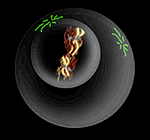
|
DNA replication precedes the start of meiosis I. During prophase I, homologous chromosomes pair and form snynapses, a step unique to meiosis. The paired chromosomes are called bivalents, and the formation of chiasmata caused by genetic recombination becomes apparent. Chromosomal condensation allows these to be viewed in the microscope. Note that the bivalent has two chromosomes and four chromatids, with one chromosome coming from each parent. |
Prometaphase I
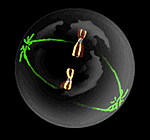
|
The nuclear membrane disappears. One kinetochore forms per chromosome rather than one per chromatid, and the chromosomes attached to spindle fibers begin to move. |
Metaphase I
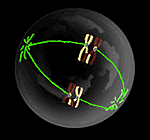
|
Bivalents, each composed of two chromosomes (four chromatids) align at the metaphase plate. The orientation is random, with either parental homologue on a side. This means that there is a 50-50 chance for the daughter cells to get either the mother's or father's homologue for each chromosome. |
Anaphase I
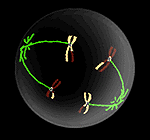
|
Chiasmata separate. Chromosomes, each with two chromatids, move to separate poles. Each of the daughter cells is now haploid (23 chromosomes), but each chromosome has two chromatids. |
Telophase I
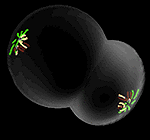
|
Nuclear envelopes may reform, or the cell may quickly start meiosis 2. |
Cytokinesis
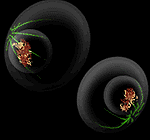
|
Analogous to mitosis where two complete daughter cells form. |
|
Meiosis 1 |
|
|
Meiosis 2 |
Meiosis 2 is similar to mitosis. However, there is no "S" phase. The chromatids of each chromosome are no longer identical because of recombination. Meiosis II separates the chromatids producing two daughter cells each with 23 chromosomes (haploid), and each chromosome has only one chromatid. |
The University of Arizona
Revised: November 24, 1999
Contact the Development Team
http://www.biology.arizona.edu
All contents copyright © 1997-99. All rights reserved.



